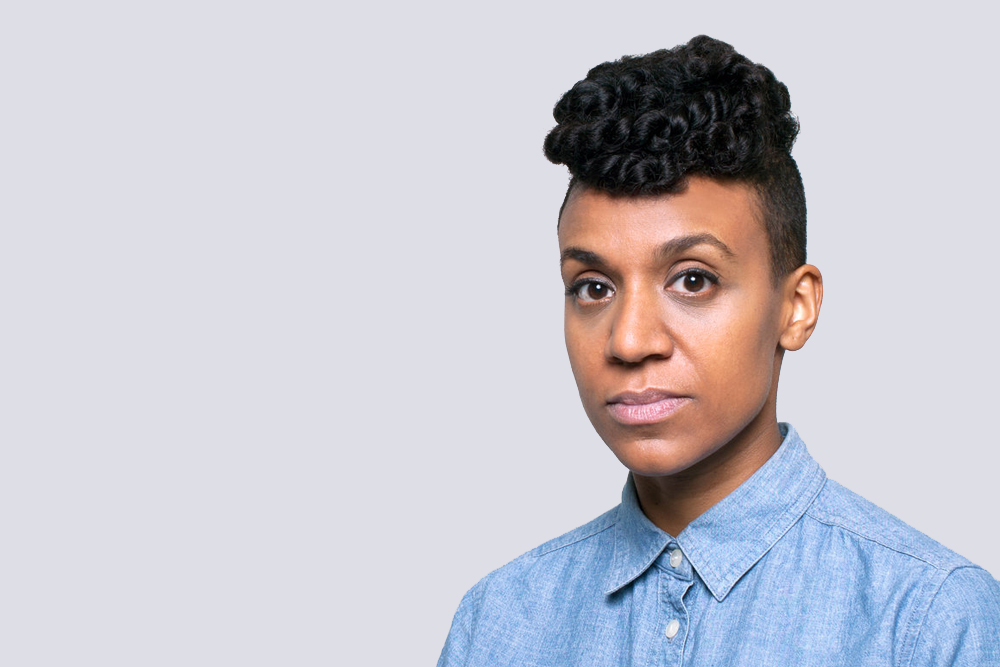You probably haven’t heard of Kapwani Kiwanga. At least, you probably haven’t heard of her if you’re living in Canada. Although she was born and raised in Ontario, Kiwanga’s career has been taking off almost entirely in the international realm.
Case in point: the Paris-based installation artist was at the centre of this year’s Armory Show in New York. There, her past series, Flowers for Africa, formed the fair’s visual identity; she opened a sisal-based installation at Galerie Tanja Wagner and Galerie Jérôme Poggi’s shared booth, and curators Julia Grosse and Yvette Mutumba selected Kiwanga (who is of Tanzanian descent) as the commissioned artist for the Focus: African Perspectives portion of the show.
But it’s not just her mounting international credentials, like her recent shows and performances at the Jeu de Paume and Centre Georges Pompidou in Paris, that make Kiwanga an artist worth paying attention to. Speaking with her over the phone on Monday in the wake of her Armory Show presentation, she was easily one of the most engaging and eloquent artists I’ve interviewed.
Born in Hamilton and raised partly in Brantford, Ontario, Kiwanga has had a circuitous route to an international art career. She first studied anthropology and comparative religion at McGill University in Montreal.
“I thought I was destined to be an academic, but I quickly realised that that was not going to be the right environment for how I wanted to transmit ideas,” said Kiwanga. “I started with documentary film after finishing my degree. However documentary film also was a bit too formatted for me. I was searching for more free forms, which I could use to express and share ideas and concepts.”
Far from being a distraction, or a detour along the way, the methodological underpinnings of her education (and, she notes, the multicultural experience of her childhood), deeply inform the approach she takes to artmaking. Her projects are structured by the rigorous research and assumed objectivity of the social and hard sciences, which she reworks to decidedly different ends.
“I use the authoritative tone as a narrative strategy,” said Kiwanga, “but I have always been more interested in a multiplicity of voices, and the parts of history that fall through the cracks.”
This focus becomes apparent in The Secretary’s Suite, the single-channel video and interactive installation project Kiwanga created for the Armory.
The Secretary’s Suite draws from a photograph of the United Nations Secretary General’s office in 1961, which Kiwanga found on the UN’s digital image library. This black-and-white source photograph captures a wall of secretary general Dag Hammarskjöld’s office, decorated sparsely with a table, some chairs, art and two diplomatic gifts: a leopard rug from Northern Nigeria and a bust of Goddess Laxmi/Lakshmi from India.
In many ways, the photograph is unremarkable. Except for a strange twist of history: Hammarskjöld died, mysteriously, in a plane crash while on a peacekeeping mission to the Congo (at a time when African colonies were fighting for independence) just two weeks after the photograph was taken. Kiwanga uses the image and its strange circumstances as a point of departure to look at the ambiguity of diplomatic gift giving, and gift-giving culture more generally.
“I’m interested in the exchange of worth and value, and what it means to have a gifting relationship with someone else,” Kiwanga said, “because this engagement is more complicated than it might initially appear—it may actually be a relationship of mutual obligation.”
The installation presents a blown-up version of the photograph transferred onto semi-transparent fabric behind a bench based on a UN model, where visitors can sit and watch a video that narrates past diplomatic gifts (also reproduced on cards presented within the installation and distributed elsewhere in the fair), ranging from the expected, such as flowers, to the odd, a wedding dress, to the downright threatening—as in the dagger and sheath gifted from Turkey to Russia in the late 16th century.
All the gifts mentioned in the work are factual, but in the video component Kiwanga begins to interject small seeds of doubt, her signature blend of fact with the slightest amount of fiction, or re-positioning, that subtly upends everything.
“Often, I would say that 98% of my work is fact—or, information that has been verified or supported by experts within a given field,” says Kiwanga. “Really, very little is actually fictional, but it’s just enough to make the audience question the information they’re receiving.”
This careful unbalancing is accomplished within The Secretary’s Suite by Kiwanga’s integration of speculation—about the possible context of certain gifts, and the death of Hammarskjöld.
It’s a typical approach for Kiwanga: a merging of overlooked history with speculative futures. Previously, she has mixed imagined futures and archival documents to look at Afrofuturism, foregrounded floral arrangements to revisit historic political agreements and researched the hypothetical “Afrotunnel” that could connect Europe to Africa via the Strait of Gibraltar.
And while a major showing at the Armory seems a busy enough way to start March, it’s just the beginning for Kiwanga this year. She’s opening group shows in Köln, Germany; Limerick, Ireland; a solo exhibition in Belfort, France; and she’s at work on her biggest solo exhibition to date for La Ferme du Buisson in Noisiel, France.









